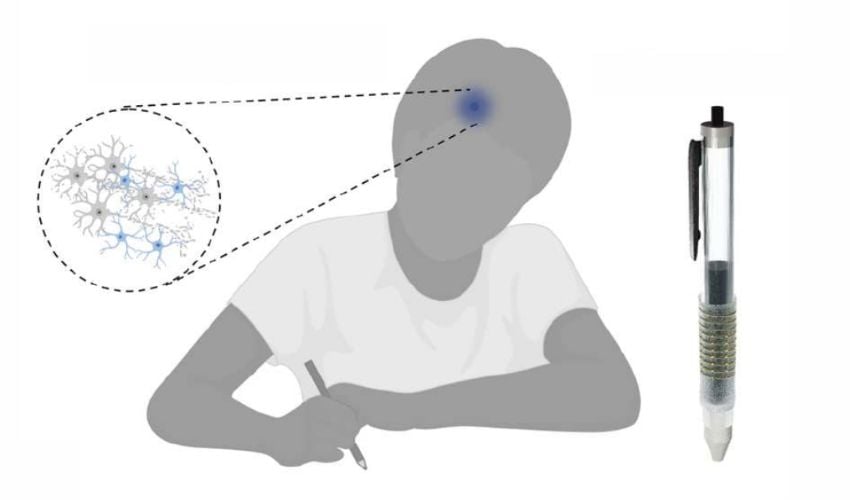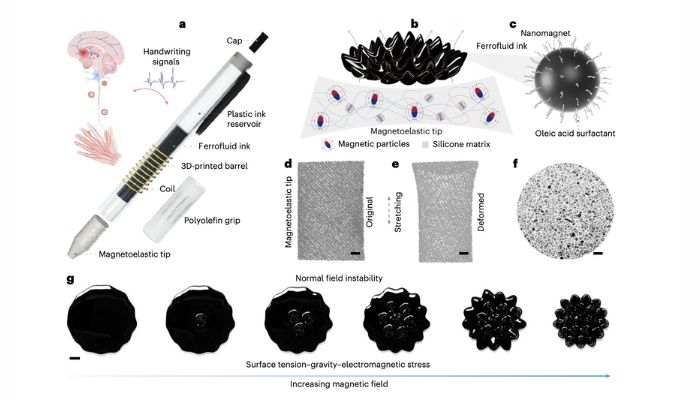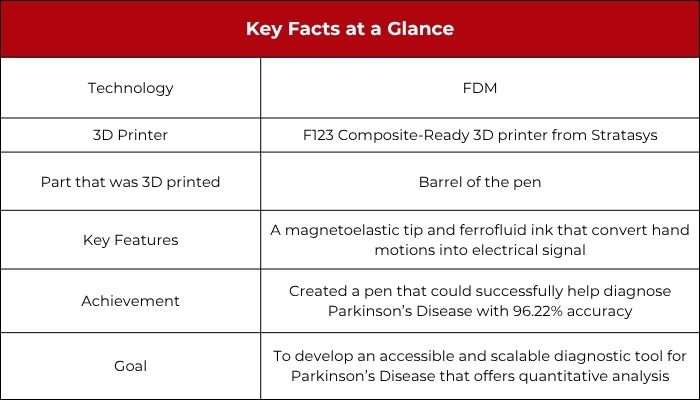Application of the Month: 3D Printed Pen for Diagnosing Parkinson’s Disease

Parkinson’s disease (PD) is a neurodegenerative disorder that affects an estimated 10 million people worldwide, and it is the second most common neurodegenerative disease after Alzheimer’s. Still, for a condition that is so widespread, it is difficult to diagnose. There are no lab or imaging tests that can confirm a diagnosis, although certain tests, like MRIs or blood tests, can support the diagnosis as PD or rule out other conditions that mimic PD. Instead, the disease requires a “clinical” diagnosis, which means that a doctor considers a patient’s history, symptoms and physical exam to determine if they have it. However, these methods are often inefficient and lack objective, quantitative standards.
A team of researchers at the University of California, Los Angeles (UCLA) is trying to develop an alternative: a 3D printed diagnostic pen. Signs of PD look different for everyone, and common symptoms include (but are not limited to) tremors, slowness of movement and rigidity. Handwriting is a process that combines cognitive, perceptual and fine motor skills, all of which are affected by PD. By analyzing handwriting patterns, users could gain critical insights and quantitative biometric markers for diagnosis.

Parkinson’s Disease patient writing with 3D printed pen (Photo Credit: Jun Chen via The Guardian)
A 3D Printed Upgrade
The UCLA researchers are not the first to think of a diagnostic pen for PD. In fact, conventional handwriting analysis tools like digital tablets have been widely used. These tools specialize in tracking handwriting trajectories and analyzing the resulting handwriting traces, but they often overlook the motor symptoms that occur during writing. Additionally, these tools are costly and complex to set up, creating a challenge for broad implementation and use in non-clinical settings. The researchers also had low-income countries in mind, knowing that they face limited access to subspecialty resources for PD diagnosis, as well as an insufficient number of neurologists.
So, the UCLA team set out to devise a tool that is more accessible and provides more quantitative results. The result was a diagnostic pen with a magnetoelastic tip and ferrofluid ink designed to sensitively convert subtle on-surface and in-air writing motions into high-fidelity sensing signals for self-powered handwriting analysis. Considering scalability, they created a straightforward barrel structure for the pen that can be efficiently produced via 3D printing. The team printed the pen’s barrel with Stratasys’ F123 Composite-Ready FDM 3D printer.
How the Pen Works
When a user writes with the pen, pressure deforms the pen’s tip, which causes a shift in the magnetic flux through the magnetoelastic effect. (The magnetoelastic effect refers to the change of a material’s magnetic properties under strain.) The magnetic flux variation, combined with the movement of the ferrofluid ink during writing, generates voltage signals in the surrounding coil. The idea is that when someone with PD writes with the pen, the voltage signals will display abnormalities not present in normal handwriting, i.e., hand tremors that register as additional minor peaks. In other words, handwriting is converted to an electrical signal to quantify handwriting irregularities.
The UCLA team conducted a pilot study with the pen, involving 16 participants, three of whom had PD. On surfaces and in the air, the participants wrote words and drew wavy lines and spirals to capture movements. Then, utilizing machine learning models, the researchers classified the participants’ handwriting signals. After training, one of these models could distinguish patients with PD with an average accuracy of 96.22%.

Diagram of the 3D printed pen. (Image Credit: UCLA)
Going Forward
For the 3D printed pen to be employed in a real-world setting, researchers need to conduct further testing. Since the UCLA study only involved 16 participants, studies with larger, more diverse pools of people must be done to verify the efficacy of the pen as a diagnostic tool. Additionally, The Guardian reported that while this pen could be a good indicator of PD, clinicians should use more than one biomarker to make a diagnosis, citing Chrystalina Antoniades, an associate professor of clinical neuroscience at the University of Oxford who was not involved in the work. Antoniades explained, “This [pen] is diagnosing the problem with handwriting, which is just one of the many symptoms that we see in our patients. But it can be complementing what we already found, picking up something that might be difficult to see.”
While it’s clear more research is necessary, the device seems like a promising tool for supporting earlier and more accurate diagnoses of PD. To read the full study from UCLA, click here.

Image Credits: 3Dnatives
What do you think of the 3D printed pen for diagnosing PD? Let us know in a comment below or on our LinkedIn and Facebook pages. Plus, sign up for our free weekly Newsletter to get the latest 3D printing news straight to your inbox. You can also find all our videos on our YouTube channel. Interested in more medical and dental 3D printing news? Visit our dedicated page HERE.
*Cover Photo Credit: UCLA







